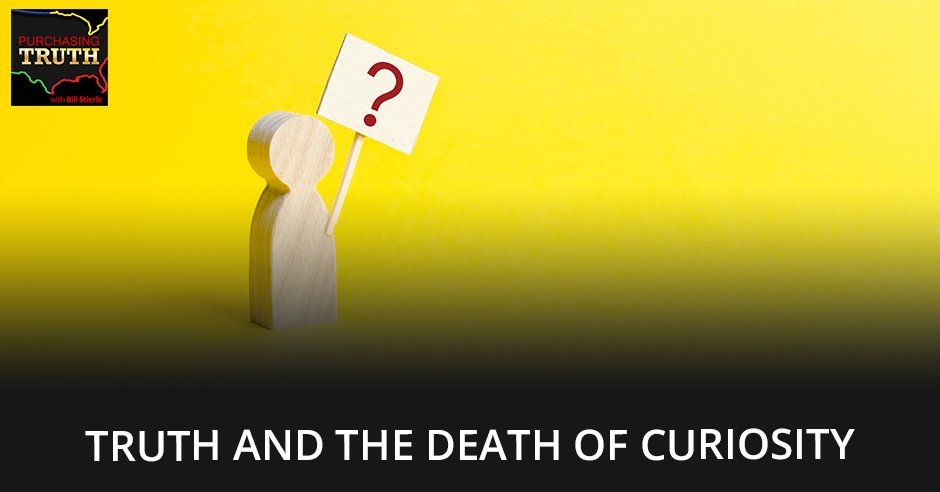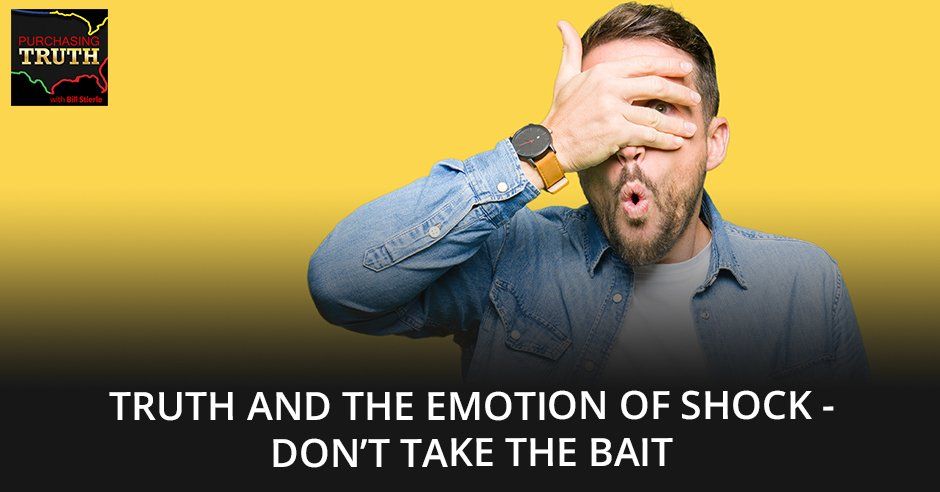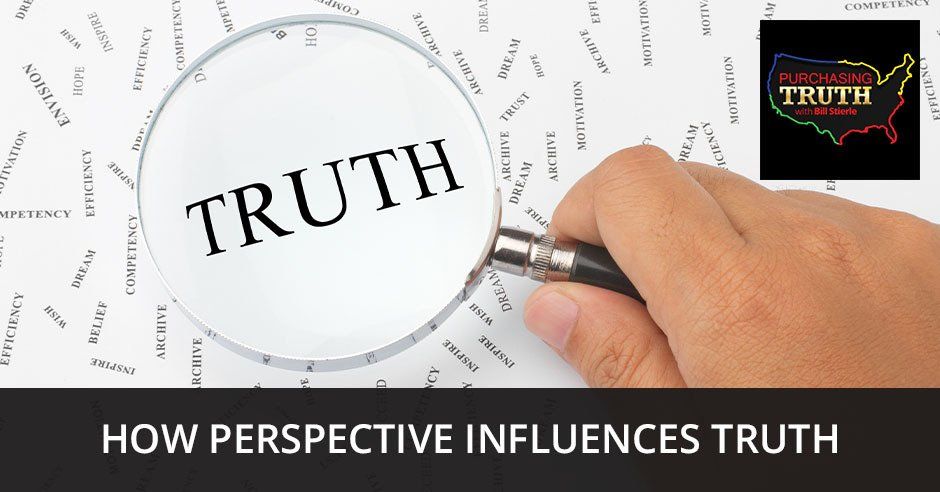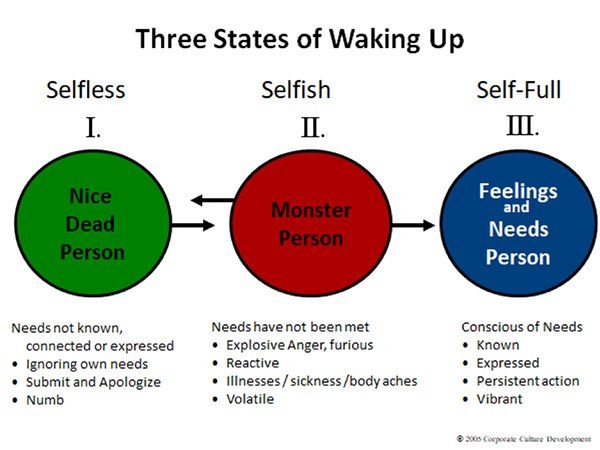Three Stages Of Waking Up
Subscribe Today!
Gaining a greater sense of what you are feeling inside as well as the feeling of another person is an awareness not everyone possesses. In this episode of Purchasing Truth, hosts Bill Stierle and Tom present the Three Stages of Waking Up and reveal the ways to know where you fall into one of these three spots. They discuss presentations of truth and how crafty manipulations that stir emotions can hijack the truth. Their analogies and illustrations will move you to examine if you are using your adult brain or your kid brain.
---
Watch the episode here
I’ve been driving around dealing with kids and whatnot, listening to the NPR and the whole dump of The Mueller Report.
We are in the middle of some messaging coming forward for both sides that are going to have an impact on a lot of different things that are going to show up next.
That’s probably somewhere we don’t want to get into in this episode, but it’s a lot to unpack.
We’re going to feel torn and overwhelmed. There’s irritation and aggravation because different kinds of needs get met at different times. There’s external triggering and then there’s internal triggering. The message is being set out this way. We then take this outside message and then assign it to or put it next to a message we have here. Those two voices start bantering between each other inside our own head. Slowing this down is a big part of what we’re looking to talk about which is how do you change the messaging from a nice dead person messaging or a monster person messaging into a scary, honest and compassionate messaging.
That is what the adult brain needs to do but regrettably the emotional brain and the kid brain hijack this.
Let’s start by recalling what led us to this last time. What brought us to this side? We were going to talk about these two opposing forces.
The big theme of this show is how do you speak truth to either truth to power or truth to yourself or truth to another person, truth to your kids and to your family members? How do you do truth in the safest way possible? A certain vocabulary doesn’t help us with that. If you go into label and diagnosis, you’re not going to get a very favorable response. Nobody likes to be called stupid or any other label or diagnosis. There’s a certain language that might be truthful and it might be accurate, but it is not helpful.
I always refer to it when I’m talking to people that when someone goes down a road that’s not helpful, despite some people might say their better judgment or despite the obviousness that it’s not going to accomplish their goals, I say, “They can’t stay away from the light,” like a moth to a flame or a mosquito to a light. Even though they know they’re going to get burned and it’s not the most productive use of their time. It’s not going to achieve the ultimate goal, they still go toward the light.
The triggering mechanism is so quick because of the way we’ve been taught to think and speak and modeled to speak and enticed to speak and think in a certain way. When people are reacting to the stimulus and the emotion goes up instantly, there is a space between the stimulus and the response. There’s not much of one, but there is space between there. If we listened to the thing from a compassionate place about what they’ve just said or did, then what happens is we actually can buy ourselves some time in our reaction. Usually the first request that I make of people is to repeat back to them what they said. That buys you time. It buys you time to think and to pick your next best sentence.
I remember you training me to learn how to communicate better for the purpose of sales, which is how we’ve engaged. You always told me to repeat back to them what they just said because then they believe that you’ve heard them, that you’ve understood them.
It puts their brain in that right frame of mind to say, “He’s listening to me. He gets me,” whether you do or not.
Whether you agree with them or not, it’s not actually as important as making the initial connection of being heard. At one time, my son when he was six years old and he was standing in front of the refrigerator goes, “Dad, get me some ice cream now.”
How did Bill Stierle react to that?
I said, “Tristan, I’m guessing you feel frustrated and you need some support and you’d like me to support you in getting some ice cream. Did I hear that request correctly?” “Yeah.” I turned his demand into a request. I identified the need that he was looking for support. Instead of letting my respect button get pushed or my best parenting, “This is the way you’re supposed to talk to people in the world.” No, that’s not helpful. It is true, but it’s not helpful to correct a six-year-old on his language choices. It’s not helpful because he’s connected to wanting to get ice cream and the support that he thinks that he needs to deliver communication in order for me to get it. He’s working himself up to get ready for me to say no instead of, “Dad, I like support to get ice cream. I’m six and I’m not tall enough to get here and I haven’t thought about pulling a chair over yet. I’m used to asking you for things.” That’s what he was asking me for support. His attitude was irritated and there’s some aggravation. He is irritated that he might hear and aggravated that he can’t do it himself. Look how compassionate you feel as soon as I said that, “The six-year-old can’t do it themselves. They can’t get their own ice cream.”
Most parents would probably say, “You’re being rude.” I’m always trying to reinforce with my kids to say please and thank you and all of this. I would say, “I’m sorry, I didn’t understand you.” That would be my natural way.
That’s the way we’ve been taught to do it. If I was to judge it, it would be a little placating and a little bit of, “I didn’t hear what you said. You could say that better. Can you put a please in there?” That’s called the coaching parent and the coaching parent is not a bad thing, but the empathy or the compassionate part is they’re feeling irritated and aggravated in their need of support and self-independence to get their own stuff.
Empathy is the key. It almost seems like empathy is Rome. All roads come back to empathy.
It all does. It’s the subtext that rides underneath language. Right now, I’m meeting my need for contribution and I felt delighted by it. That’s my empathetic motivation. Yours is feeling inspired because your need for learning is being met or energized because you’re supporting me to get a contribution to people. That’s huge because that’s your subtext and that’s my subtext. Now, even as sub-stating it out loud, I feel better and you feel better. The rest of the audience is going, “Thank you for the window about what’s happening inside you.”
I think that’s good for people to understand, especially as this is one of our earlier episodes in the series.
Coming back around to the way truth gets impacted about this is that people believe the context sentence to be true instead of the subtext sentences where the real truth is. Empathy is the real truth that’s running underneath each sentence. We’ve said this before in other episodes, but empathy only occurs when you get this feeling word and a need word, connect it and then have an agreement that, “Did I have that right, Tristan? Are you requesting me to get ice cream and you need my support?” He says, “Yes.” Empathy has occurred. Then I said, “I’d be happy to get you that.” If I didn’t want to get him ice cream, I need to get ready for empathizing with that, “Which is I feel torn. Part of me wants to get you ice cream and another part of me wants to remind you that we’re having dinner in half an hour,” which six-year-olds could care less about. They’re going after their thought. The thought is ice cream is in that refrigerator over there. That’s all they’re doing.
Truth gets hijacked because all you’ve got to do is say a monster person sentence and many people submit to that right away, whether it’s a Congress person or a Senator or whatever, the public or a politician that is using a narrative that is a power over narrative. It’s a narrative of, “I’m going to get progress and rollover people to get there and not really consider what an honest dialogue or what an honest inclusive thing is.” You might already have the best answer, but if you’re beating people up along the way, you will get compliance but you will get backlash. That’s what is missing.
The people don’t know that when you’re in a monster person state, what winds up happening is that you’re going to pay for it later and you’re going to pay for it in such a way that you’re going to wish that you never did that. That’s what you’re going to do. You’re going to wish that never took place. The good news and the bad news, the good news is there is a way to navigate through creating discernment in language to know when you’re falling into one of the three spots. It’s called the Three States of Waking Up. When I was coming up with it, I was going, “Is this the Three States or the Three Phases? No, it’s states. I can be in state number one. I could be in state number two or be in state number three. I’m not stuck in any one of these states. I can move between each one of them to either energize humor or to make a point or to get power over instead of power with.”
There are going to be three circles. The third circle is where we want to spend most of our time. What that looks like is I have a greater sense of what the feeling is that’s happening inside me as well as the feeling in another person. This is not a nice language. This is a power with language. What is the need that the person is going with and what is the need that I’m advocating for? When we do that in our conversation between you and I, Tom, is that our need is known, contribution, service, awareness, effectiveness, how to communicate to reduce conflict? That’s peace. Those are big motives. We know what our needs are and that’s really what the truth of our conversation is. We’re expressing them as I did it. It rolled off my tongue a little bit.
Fighting for them is the persistent action and there is a vibrancy in when you’re fighting for peace or justice. There’s a vibrancy when you’re fighting for fairness and equality, truth-telling. We want to make sure that language isn’t hijacked because we’re talking about a specific thing. What’s happening now is when somebody is making a point about something, the other person tries to say, “This matters too.” It’s like, “It matters. This is important, but you are already getting that. We’re not getting this.” This narrative is not about respect. It’s about justice and safety. It’s not about respecting something. It’s not about patriotism. It’s about how fairness works and how justice works. That’s what actually what we’re talking. The counter-argument is the other side tries to raise this thing equal to the thing that the person’s arguing and that’s called setting next to or setting a side by side equality. The current label that’s going on right now is called false equivalency. The thing is that they’re really apples and oranges. It’s, “Respect looks like this and fairness looks like this.” It’s not about that. You’ll hear media use a turn phrase called What About, “What about this?”
That’s trying to buoy or push up the other narrative to diffuse the truth or the advocacy that the person is speaking about. If the third position or the third circle of the Three States of Waking Up is I have compassion and I’m able to express my needs in a really powerful way, what are these other two circles that are going to bring up? This is where the violence starts taking place. The violence has to do with emotional management about how we want to stay connected to another human being. As soon as the emotion of an upset takes place, what happens is we need to become a nice dead person. That’s the first circle I have.
A nice dead person is like, “I’m going to be submissive. I’m not going to be able to be in touch with or express the need that got ran over by a truck. I’m going to ignore my own needs and then I’m going to submit or apologize.” Submitting is not saying anything or apologizing, “I’m sorry about the needs I would like. Your needs are much more emotional and much more important.” This numbness shows up. The reason why the numbness has shown up is that people don’t know how to talk themselves out of a nice dead person position.
The psychological label that can be put in this position is like either codependency has in this spot or some of these other psychological labels. If we don’t know what our need is, then it’s really hard for us to advocate for it and our emotion or a fight and freeze gets stuck and our body shuts down. We walk away and ruminate about it for a week, two months, a year or four years. It’s awful stuff. That’s the nice dead person experience. The problem then is what’s the second circle? The second circle is going to be the monster person. The monster person also is not in touch with their needs. Their needs haven’t been met, but they can’t take it anymore. They’re going to stay in a place of anger or furiousness or reactivity. The monster person keeps triggering the same stimulus narrative over and over again and it creates volatility. Whereas the nice dead person, they’re numb, the monster person is advocating volatility.
Some people might say, “Bill, I don’t get angry but I do get resentment and start to seethe.” I ask, “That means you’re doing anger on the inside. How are your illnesses going? How’s the sickness and how are your body aches going?” “My body hurts all the time. I’ve been sick four times this year or seven times this year. I can’t get rid of this chronic disease that keeps coming back.” Your body is taking the cortisol that it wants to express outside and you’re just making your own self pay for it by doing a monster person on the inside. The weird part, this is when I started going down this journey, I had this awareness like, “It’s our word choices and our thought choices that are keeping us pinned between this nice dead person, this monster person and it’s preventing us from getting to, “Here’s what I need and here’s what I’m requesting.” If you think how simple that one is, what am I needing and requesting? It makes a big difference. Tom, you tell me what might be a ruminating thought that you might have between this nice dead person thought and this monster person thought about what you should get done or shouldn’t get done? What would your family members like to happen three days ago and is still poking you with a stick about?
I’ve never been very good at self-reflection in my life. I may have ever gotten better over time. Holding up a mirror to myself and understanding myself is not really one of my strong suits. When I saw this nice dead person and monster person come up and hearing you talk about it, I’m thinking, “Needs not being met, explosive anger, furious and reactive, we see this so much in our current political climate.” That’s what I started to see and I started to place individuals in there. It happens on both sides. We see it all the time. This is part of why everybody feels there’s so much dysfunction in Washington and why Congress won’t work together. The other side aren’t working together because they are all trying to be this monster person.
They’ve noticed that the monster person allows you to get elected or the monster person is getting you to just have enough votes to be elected and then also justifies or validates your position that you then get to bring a monster person or it has to be done this way. You’re going to win the battle in the monster person’s place, but you lose the war. You’ll win the battle in monster person, but you will lose the war. The army of people that are submitting and being nice to that person is like, “No, we’re not doing that.”
We saw that a little bit in 2018, the midterms, “You want to do a monster person? “We’re coming. By the way, we’re coming in greater forces because we’re going to watch this and we’re not going to take that anymore.” You can’t keep coming back to the monster person and actually get a sustained win. This is where it gets sad and disheartening because if you’re constructing a democracy that is inclusive with language, you’ve got to allow the monster person to express themselves. We’re not interested in pressing that down, but instead of moving back to the first position. If you move to the third position, then it’s easy to diffuse a person that goes into the monster person. Many politicians have no clue about what I’m talking about right now.
That is sad because they’re in a position to be able to have the floor, if you will. They have the pulpit. They have this ability to reach many people. If they would only choose their words more carefully and truly be thinking about, as you say, bringing their feelings and their needs together, their communication would be far more effective.
It’s going to land further. It is never about policy or truth or facts. To let that sucker sit in it is not about who going to have the right plans. It is not about who is going to have the right set of facts.
The person that wins the election, let’s just say metaphorically, whatever election is not going to be the person with the best ideas. It’s not going to do the person that has the facts on their side. It’s going to be the person that communicates more effectively and connects.
It’s got to connect with the pain that’s alive.
I have a memory I want to share with you and it was the 2008 election running up to it in the primaries. There were interviews, I don’t know if it was back to back Sundays where Barack Obama was interviewed on 60 Minutes and then Hillary Clinton was interviewed on 60 Minutes. If you watch those two interviews side by side, I could see why Barack Obama was going to win the primary and be the candidate because he would always talk about, “We want to do this, we believe this.” It was all “We.”
The “We” part is important. He was also including needs-based language in his narrative so that the people were able to bring their emotions to their vote, not vote for what’s best.
When you listen to Hillary Clinton being interviewed, it was always, “I believe this. I want to do this.” It was very self-centered in how it was communicated. Personally, I believe Hillary Clinton has a big heart and wants to truly help people and she has to live a life of service to do that. I personally believe that but I could tell that message is not going to resonate. It’s going to fall flat.
It falls flat because of the viewer’s language, the person’s language, each one of these three circles, if we put the simple psychological label to it, the nice dead person is in a position called self-less, myself is less. I’m in a submissive position. The monster person is the position of selfish. You can’t call them that because they are advocating for a need that’s similar to ours. The third position is self-full. I am fully bringing mutual respect to your message. I’m going to respect my message and your message and my message. It’s the confidence about which person is actually going to be able to deliver what they are talking about. My favorite debate is between Ronald Reagan and George Bush.
This would have been in the primary season prior to Ronald Reagan getting the nomination and run up to 1980?
That’s right. You can YouTube that. It sounds like two socialists, talking about how important it is to have an open border between Mexico and the United States. They’re both talking about it and the only difference is that Reagan was an actor and George Bush wasn’t and he delivered the message a little cleaner than George Bush did it. They were basically talking about the same thing. With that message right now, they could not get elected because they sound like Democrats. To be honest, I’ll take either one of them right now. At the same time, when a person is connected to the internal motivation of what needs are they advocating for, instead of what they’re going to do or what they can do? What happens then is that we’re able to get out of the medias dancing back and forth between what is the next monster person tweet that is going to show up? What is going to be the next media monster person response to the monster person tweet? We’re not going to take that in more. Now, for the first two years, the media spent more time in the nice dead person especially the first year of Trump. He’s going to become presidential. He’s going to pivot. He’s going to see what the job is going to be like. He’s going to be able to understand this is the role.
There’s no pivot. It’s the monster person all the way and he gets furious. I don’t have a personal experience that directly, but one of my family members has direct personal experience of that. It’s like craziness in the sense of how the narrative of monster person power over those. Look at the derogatory on the nice dead person’s snowflake. I don’t think that is fully qualifying about what is actually happening. What’s speaking truth to power is what’s starting to take place. Truth is something that the monster person has realized that, “I can string it out. I can out marathon truth.”
I want to unpack that a little bit because we talked about in the previous episode beliefs and how beliefs can be manipulated or altered at a minimum. Isn’t it your position, that truth actually is absolute? Now, you’re talking about it succeeding in spite of truth without outrunning it.
Here’s where it gets weird about the way truth really actually works and the way our brain physiologically responds to truth. This is a metaphor called the Bill Stierle Truth Pie. The truth pie is like an apple pie. The apple pie is sitting on the kitchen table at Thanksgiving. The apple pie is behind me. You, Tom, you can see the apple pie but I cannot. You see a fly come into the kitchen and you see it land on one of the corners of one of the slices of this apple pie. Do I see the fly? No, I don’t see the fly. Your truth is there’s a fly on the apple pie. I turned around a microsecond before that. The fly has lifted. I go, “Where?” For me there’s no truth in that because I haven’t seen it.
It doesn’t mean it didn’t happen though, right?
That’s correct. It doesn’t mean it didn’t happen. All I’ve got to do is keep talking about the possibility of it either not being there or the possibility of it being there. Now, I am populating the belief that either there are flies on the pie or there are no flies on the pie. Think about this conversation regarding truth, regarding global warming. There are flies on the pie and one says, “No.” “I have this research here done by this document that says it’s been disproved. There are no flies on the pie. I want to drive the car the way I want. I want to ignore the environment.” It’s like, “What are you doing?” “It’s over hundreds of thousands of years.” It’s like, “No, there are flies on the pie. We’ve got to address how we keep putting flies on this pie because we’re living on this thing?”
I see your marathon or out-running truth metaphor a bit. Might we also say that like a horse that has blinders on, by someone who is this monster person moving forward as fast as they can, they don’t want to see the flies on the pie. They’re ignoring the flies on the pie and making it so that they don’t see it. Almost like the toddler who is not wanting to be seen and hides their eyes and thinks no one can see them because they can’t see them back.
That’s correct. The blinders are a great metaphor for what people do with truth. “My belief structure has to be this. This person’s in my tribe. I have voted for this person. I got inspired by it. We’re not going to take it any more narrative.” Our belief is to stay in place rather than the world has changed your beliefs can be yours, but they can’t be everyone’s because the world keeps changing and moving. We are working and activating in the place of global existence now whether you like it or not. This is where the truth is.
Somebody will put up a wonderful research piece or a documentary or some of the work that’s being done with the talk shows, especially the comedic touch shows is, “We want you to look at this part of the truth and we’re going to laugh about the flies you’re putting on the pie over here.” You’ve got to look at the perspective here.
Humor helps us with perspective, but it doesn’t necessarily get us over to being in action. We’re still regrettably struggling with our language patterns and our belief patterns being stuck and being advocated for from a time that is long past. We’re not in ’50s America. We’re not ’40s America. There’s a lot of stability around. We were creating an economy that actually works and is balanced and there’s a lot of safety all the way to the end. The main thing about the nice dead person and the monster person is getting your need for being heard and contribution and the insights that show up in our brain and the examples that come with it, that’s the way our mind works.
They want to collaboratively work with argument moment. That’s delightful to embrace. How do we get our needs met and the needs of another person? There are times when they both can’t be met at the same time. The truth is that it’s sad. We feel disheartened about a certain type of work called coal mining in the place of not being as financially feasible as it once was or as needed as it once was because of natural gas. What wiped out coal was natural gas and not the other things. Even that truth, as I speak it, and as it’s validated, the person’s going like, “No, solar and wind are.” It’s like, “No.” It’s not natural. It’s hard to get the truth to take place.
The whole coal thing is a good example because to me that was a real serious example of pandering to a lobby or an icon of the American industry that resonated with a lot of people and still does in the election cycles. The truth or maybe the flies on the pie that those people who believe that do not see because it actually there are more jobs today in the United States in the wind and solar, in a growing industry, not a shrinking industry that is truly clean. As long as you don’t believe that the windmills’ worrying generator noise doesn’t cause cancer as some people would have to believe.
That’s a good example of a monster person narrative. It’s trying to trigger and set a wind turbine next to a disease that people had been affected by. I’m setting this thing next to this other thing and I am going to brand and propagandize that to be, this is next to this. Most people logically would go, “There’s no evidence and it’s not based upon it. That’s not what just happened.” What has happened was I took this thing and set it next to this thing that’s dangerous, therefore, anytime I think of it, I think of the dangerous narrative. I don’t think of the forward-moving narrative, the positive narrative because the brain will say, “Cancer and that go together.”
That’s the tapping of the elephant brain like we were talking about before. They just tapped that and what he did was he tainted this very clean, free energy. You have to build windmills anyway, but it is relatively free. He tainted it with one of the most feared things in human existence.
Most families have been touched by one family member somewhere in the last generation of, “They passed of cancer.” “That’s something that’s going to be dangerous, wind turbines and that being next to each other.” The way truth gets hijacked is that I am going to create an enemy image or a dangerous image with this thing that is really not dangerous, but it’s something I am an advocate for and the people that I advocate for are going to do. If push comes to shove and somebody comes to my front door and says, “I came here from another country. I’m getting killed there. Can I borrow your backyard and put a sleeping bag again?” I go, “For the time being, that will work okay for me but we need an exit strategy for you to move and get on your own. Is that okay to come up with the next exit strategy in the next 30 days?” The person then says, “I would like an exit strategy. As I get to that exit strategy, can anything I can do for you here?” “There are a lot of things you can do for me.” That becomes a bartering narrative, bartering time for support. Human beings are naturally collaborative and cooperative. They’re not naturally competitive. You have to do something to become competitive. This particular belief is a very old belief. It comes somewhere in chapter four in Darwin’s On The Origin of Species. If you think about Darwin’s On The Origin of Species, as soon as a religious person hears the dark Darwin origin species, they go, “No.”
It’s counter to their beliefs.
Let’s go and peel that one back. The belief is if you think about one sentence or maybe a couple of sentences that would come from that book that lasted, what would be a belief that would come out of there of what does a species need to do?
It needs to evolve. It’s the survival of the fittest or natural selection.
You did two things together. You said the fittest and then natural selection. Do you see how you had those two things? Those two different concepts. Tom, have you ever started a book and didn’t finish reading it?
Trying to get your needs met at the expense of others is the cannibal capitalistic model.
CLICK TO TWEET
Yes.
Me too, hundreds. At the beginning of the book, he actually goes into this survival of the fittest piece and many people got to that thing, “This book is about the survival of the fittest.” Later in the book, he gets into the thing called natural selection. Here’s what it gets weird and upsetting at the end. At the end of the book he says, “If a species does not co-evolve together and one species wipes out their food source in a competitive nature, they go extinct. Collaboration and cooperation are what species do when they co-evolve with their environment.” Tom, human beings are not co-evolving with their environment, are they?
No.
We’re dominating the environment. We’re not co-evolving and the rest of the species are going like, “We can’t make enough fish sustain this species. We can’t have enough plants to sustain the species.” What happened is that we’re actually taking survival of the fittest. We’re the fittest, but that’s what Darwin is actually warning about is that if the person is dominating, surviving, because you’re the fittest person, you’re up for extinction next. You’re actually not in harmony or collaboration with your environment, with all the different species. All the different species are plummeting. Forget about reptiles in 200 years or 100 years and the person alive now will go like, “Who cares about reptiles? We’ll keep them in a zoo. There will be pictures of it. There will be a documentary. I’ll be sad about the Dodo once it’s gone.” It’s like, “No, the web of life, as soon as you start pulling on it, the web doesn’t work so well.”
These other things are pulling on each other.
Everything would get out of balance and harmony with each other and sustain each other. That makes perfect sense. Bill, a question has popped in my mind as we were talking about the monster person and especially the windmill cancer. I used the term false equivalency the last time. Maybe you don’t like that term so much.
It’s a good label to start. Labels are an okay place to start, Tom, but as soon as you say false equivalency, now you have to get into say, “What level of truth is this one part of the truth and what level of truth is this part of truth?”
Clearly the current president, it would appear is a master at doing this. My question is, “Is that intentional or is it instinctual?”
There’s a little bit of his habit brain that has been brought up to speak and think this way. It has been a very successful narrative because he’s been able to speak and think of the way. It speaks in three ways. There’s a reward, there’s an anticipation and there’s uncertainty on whether or not he’s going to get it. He’ll keep ruminating between those three pieces. All of those three sentences are called dopamine hitters. They all make the dopamine in the person sit up, listen, react, embody and engage. You can watch tweets and you watch him. Is there a reward? Yeah. Is there anticipation? Yes. Is there uncertainty? Yes. Is it in your face? Absolutely. All of a sudden, it’s to keep engagement moving forward. That’s what branding is. It’s engagement. Coca-Cola has engagement, Pepsi has engagement. It’s an engagement process. It’s not a truth process. It’s trying to keep the brain paying attention to this product or service. Trump’s product and Trump’s service, all he’s doing is keeping people engaged in it. The content is not as important.
He’s dominating the airwaves, sucking all the air out of the room to talk about other things that may be more important, more meaningful or what might meet other people’s needs.
The needs of the few get to run underneath the radar and that’s disheartening because what winds up happening is that communism doesn’t win. Socialism doesn’t win. Democracy doesn’t win. What wins is who gets the strongest branding imprint to distract from people meeting their needs at the expense of others. We’re back in the competitive survival of the fittest. It’s the survival of the brander. It’s a survival of the imprinter. I’ve got to keep my negative message in front.
Imagine if someone who had more caring bones in their body to have more empathy for the country at large, the world at large. As you said, cooperation is necessary for us to sustain ourselves.
It’s a much healthier form of capitalism. Here’s a healthy form of capitalism. If I take ten internet companies and get them to compete against each other in a nation, those ten companies in that nation, they’re going to be looking at cost-cutting, efficiency, margin stuff being more effective and they’re going to keep working on quality. I have 4G, I have 5G. I’m able to do that. Wouldn’t it be great if we had like 8G? Wouldn’t that be good?
Some countries do that because they have ten companies competing, but if you don’t have anybody competing, you can deliver 4G or 5G and the person’s got to suck eggs while the rest of the other country that’s competing in a cooperative way is actually getting the better service at a lower price. That’s the story of South Korea and the United States. I gave you an example of cooperative and they’re working against each other to say, “We’re a little better. We’re a little more efficient. We’re doing this. We’re trying to get your eyeballs,” but they’re working and they’re doing things like, “How can we make it better for the customer?” Whereas in America, it’s, “How can we make it better for the company? How can we wipe out the competition? How can we buy out the person? We’re going to buy out the person. Why will we compete with the person? Why don’t we buy him out, give the money to the shareholders, bring them in and wipe out the competition?”
I don’t have to innovate. I don’t have to be more efficient. I don’t have to cut my overhead or my cost to be more profitable. That makes sense. What about in our political climate? If we had somebody who understood and believed in the cooperation and had empathy and then actually learned to communicate better like we’ve been talking about, they would win.
They actually win from the place of, “I don’t want to be exhausted by a monster person’s narrative. I’m going with the person that is at least making some sense about, how can we get the need for mutual respect to be met?” Barack Obama did that pretty well. He goes, “What we really need to do is empathize with the other side. We need to put ourselves in that person’s shoes. The competition can’t keep going like this.” He got elected the first round by that thing. I remember an interview where he says, “Put yourself in somebody else’s shoes. See what they’re going for. Work with them.” They took advantage of that for about the first year. After that he figured out, “I got the game, here’s the game and we’re moving forward. We’re going to consider them, but we’re not going to deal with the obstruction piece as much.”
You see what happens is all of a sudden, they were able to create all kinds of stories, put more flies on the truth pie to believe that he’s going in a direction that the nation doesn’t want to. That wasn’t true at all. He’s going to address the nation as they want to, but they all fought, fell back asleep in the nice dead person. Now, the savior is here. He’s going to take over. It’s like, “No. You’ve got to stay active in the third circle an advocate for your needs and watch out for the other people trying to get their needs met at your expense. They’re in the cannibal capitalistic model, power over the monster person.”
The label diagnosis is a good place to start. The healthier place, the adult place, the place that is really one that is going to get us out of the wedge that we’re in is going like, “This is the way this one works.” We can go to the Russian model where there are thirteen major billionaires and as Malcolm Nance would say, “There’s a trailer park with nuclear weapons.” It’s like everyone else is poor because these other people have sustained, embodied and aggregated their wealth in one place. It doesn’t create a vibrant economy and it doesn’t create an experience of people having joy in their life. Who wants to be joyously waiting desperately for their check to come every Friday and go paycheck over paycheck? Who wants to do that? Who wants to go years without a vacation? Who wants to do that? We want to get ourselves into a balance of being in life at the same time as doing in life, not just become human doings.
That’s a great message there, Bill. We should let that one marinate. Maybe that’s a good place to wrap up.
Tom, I feel delighted that we went over this concept of the Three States of Taking Up. Catch yourself at moments where you’re submitting and being the nice dead person and go, “I don’t have to be in that spot.” I can go over and say, “I need five more minutes in order to fix this. Would you be willing to leave the house and in another fifteen minutes rather than in the next three minutes?” Ask for what your need is rather than getting to, “I have too much stuff to do.” It’s like, “Of course, you do. I just need a little consideration here to move forward.” This has been great, Tom. Until next time.
Bill, thanks so much.
Thanks a million.
Important Links:
Love the show? Subscribe, rate, review, and share!









